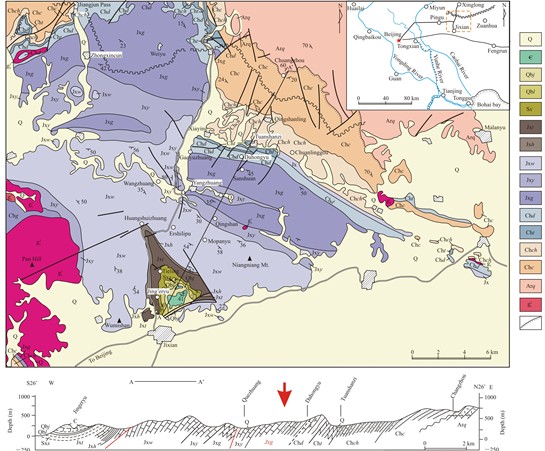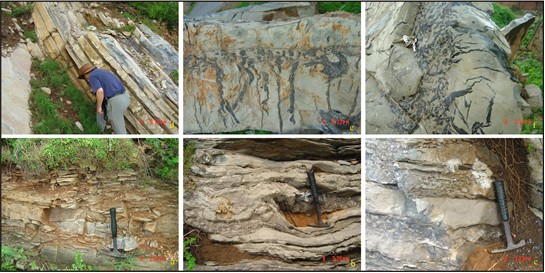Gaoyuzhuang Fm
Type Locality and Naming
Jixian County, Tianjin. The Gaoyuzhuang Fm was named by Kao, C. S. (Gao Zhenxi), Hsiung, Y. H. (Xiong Yongxian) and Kao, P. (Gao Ping) in 1934. The type locality Gaoyuzhuang is a village of Xiaying Township, Jixian County, Tianjin Municipality. Coordinate: N40°10´00″, E117°28´00″.
[Figure: The Mesoproterozoic strata in the Jixian section in Jixian County (Tianjin Municipality)]
Synonym: (高于庄组)
Lithology and Thickness
The Gaoyuzhuang Fm is dominated by carbonate rock (up to 95%). The stromatolites are developed in lower part; the middle part contains manganese, while the upper part bears siliceous or dolomite concretions of multiple shapes, and the lime and bituminous content increased in the top of the formation. The base is marked by grey-white pebbly feldspar-quartz sandstone, which contact with underlying Dahongyu Fm in disconformity. It is subdivided into four members. The base of No.1 member is grey-white sandstone of 3 m thick. Upwards it is replaced by cherty dolomite and muddy dolomite, intercalated with dolomitic sandstone and dolomitic siltstone in which developed the banded and nodular chert. Both cross-bedding and scouring structures are seen on the bedding surface. It recorded to 347 m thick. No.2 member is 320 m thick. The lower part is composed of Mn-bearing dolomite and Mn-bearing silty dolomite, while the upper part, microcrystalline dolomitic limestone with micro-straight-flat bedding. No.3 member, 658 m thick, consists of interbedding of platy-bedded or thick-bedded muddy dolomite and limy dolomite with parallel and straight bedding. The crustal and pisolitic concretions are rich in upper part. No.4 member, 217 m thick, has a basal part composed of brecciated bituminous dolomite; lower part of medium- to thick-bedded coarse-grained dolomitic limestone; and upper part of thick-bedded chert-bearing coarse-grained dolomitic limestone. The dolomite contains terrigenous and basinal clasts with undulating bedding, multiple concentric concretions and intergrowth concretions. Stromatolite and microplants are found in the formation in all localities, only differing in abundance. It is less changeable in thickness and basically stable in lithological character. It is dominated by dolomite, but the difference in all areas is only in abundance of sandstone and schist interbeds as well as their thickness. The total thickness of the formation recorded to 1596 m.
[Figure: a-The lower part of the Gaoyuzhuang Fm.; b,c-Algal-ball horizons in the third member of the Gaoyuzhuang Fm; d,e,f-Molar-tooth structures in the fourth member of the Gaoyuzhuang Fm]
Relationships and Distribution
Lower contact
In the Yanshan area the formation is in conformable or disconformable contact with underlying Dahongyu Fm. But in West Yanshan region it directly overlapped on Tuanshanzi Fm. The next younger unit is the Yanzhuang Fm.
Upper contact
It is conformable with Yangzhuang Fm
Regional extent
Tianjin, Hebei, west Liaoning. The formation widely distributed in the Yan-Liao region, and is more stable both in lithological character and thickness. In Yanshan Mountain area, in Kuancheng (816 m thick), in Pingquan (629 m thick) the clastic rock and claystone increases, while in Qianxi (1963 m thick), Qian'an (1796 m thick), Luanxian (264 m), Miyun-Nankou (1242 m), Yixian (823 m), Quyang (885 m), Zhuolu-Xuanhua (1018 m), the Fm is still dominated by carbonate rock, and the difference lies only in the higher or lower areno-argillaceous content. In west Liaoning region it is found together with underlying Dahongyu Fm, for example in Lingyuan (1284 m), Chaoyang (1374 m), Yixian (1271 m).
GeoJSON
Fossils
The stromatolites in the formation are mainly Conophyton cylindricum, Gaoyuzhuangia gaoyuzhuangensis, Jacutophyton f., Confusoconophyton multiangulum. The microplants: Asperatopsophasphaera umishanensis, Trematosphaeridium minutum, Polyporata obsoleta etc. In addition, there are abundant blue algae fossils in chert rock. In Baoshenmiao Village, Lingyuan County the formation yields microplants: Asperatopsophosphaera partialis, A. umishanensis; and the stromatolites found in Xingcheng County are Conophyton cylindricum, Stratifera f., etc. In Sangshu'an Village there are macroscrophic algae fossils.
Age
Depositional setting
Additional Information
The paleomagnetic polarity of second member of the formation was negative with a paleomagnetic pole at 0.8°N, 66.7°; that of fourth member was also negative with a paleomagnetic pole at 0.5°N, 48.5° (Zhang Huimin et al., 1991).

